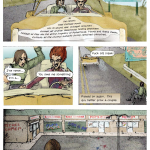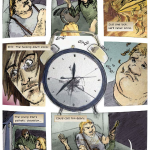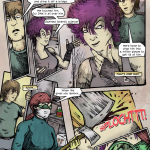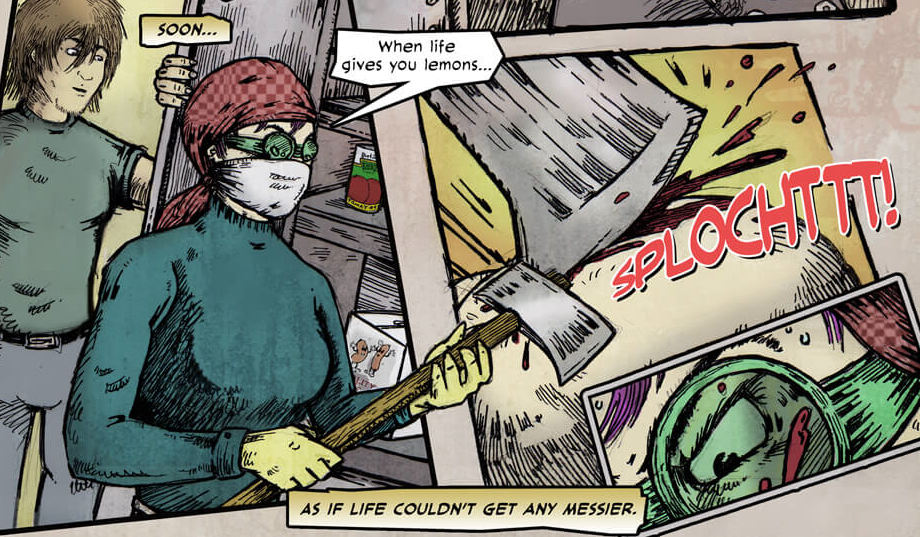Philip’s note: I was approached to review volumes one and two of the Prime Cuts graphic novel. And, frankly, I would have done a great job with that. But, in fairness, my comic experience is pretty thin, so I am proud to feature a much more educated and reliable review from Scott Gregson, who posts here often as RaikoLives. Thanks, Scott. Also, thumbnails are for clickin’. Enjoy!
Alright, look, I’m not gonna say I hated it. I know, I know, spoiler alert for my own review and all that, but yeah. I didn’t hate it. As such.
“It” in this case is a pair of graphic novels; Prime Cuts: Volumes 1 and 2, written by John Franklin and Tim Sulka. Art for Volume 1 is by Rob Gutman, while Stan Maksun did the art for Volume 2. And in case you’re wondering, “graphic novel” is really just a fancy way of saying comic book.
Prime Cuts starts off with our main character’s past unfurled as an incoherent vision of ugly people doing ugly things in an ugly way and, really, doesn’t go much further than that. Even by the end of its second volume our hero, a young man by the name of Todd Sweeny, has accomplished very little, and beyond his most recent past we know almost nothing about him. We know a little about Electra, the other main character, and some details about the dark and gruesome world they live in, but much of the story’s momentum is lost whenever Todd becomes the focus.
If his name seems familiar, yes, Prime Cuts is a dark, modern take on the legend of Sweeney Todd, and while I’m only loosely familiar with the original story, I can already tell it isn’t straying too far. At least not yet. Our hero, Todd, is a hairdresser by trade, and the death of a man leads to the same cannibalistic fate as so famously defines the original story. Most of where Prime Cuts seeks to differentiate itself is in the tone it sets. A blend of the vile and the gross. With a healthy dose of sex, swearing and gore. And that’s great, if you’re into that kind of thing. But when it becomes the sole focus of your story you may need to rethink your project.
 Artistically, Prime Cuts is a mixed bag. The first volume’s art by Rob Gutman would be easy to dismiss as amateurish (at best) or just terrible (at worst). It’s not great, but Gutman’s line work in places is surprisingly strong. Closeups of faces look good, and he manages to keep his characters details looking consistent, which is something a lot of artists struggle with. It’s when his characters interact physically, either with each other or the environment, that the problems begin to show, as his figures lose themselves within the panels, floating weightlessly. It’s the nature of drawing sequential art, as opposed to simple figure drawing, that your figures need to reside within a picture, within a story, and while Gutman’s work isn’t entirely without merit, often this aspect escapes him.
Artistically, Prime Cuts is a mixed bag. The first volume’s art by Rob Gutman would be easy to dismiss as amateurish (at best) or just terrible (at worst). It’s not great, but Gutman’s line work in places is surprisingly strong. Closeups of faces look good, and he manages to keep his characters details looking consistent, which is something a lot of artists struggle with. It’s when his characters interact physically, either with each other or the environment, that the problems begin to show, as his figures lose themselves within the panels, floating weightlessly. It’s the nature of drawing sequential art, as opposed to simple figure drawing, that your figures need to reside within a picture, within a story, and while Gutman’s work isn’t entirely without merit, often this aspect escapes him.
His panel layout, too, is somewhat lacking inspiration, with borderless squares and grids the order of the day. This hinders the pace of the story, as often the nine-panel grid format fails to capture a sense of movement or tone, leaving the story feeling dull. Lifeless. One particular full page panel gifts us with a character’s passage through it, and I enjoy the way Gutman plays with the panel, relishing the concept of a panel being at once a specific moment in time, as well as depicting a specific passage of time or moment. The page, though, uses large arrows to frame the character’s journey throughout the scene, as neither the art nor the positioning, or flow, of the dialogue are enough to sell exactly how it plays out otherwise. It’s a tough trick to pull off, for sure, and a neat exercise, but when you’re forced to use arrows within your splash maybe it’s time to rethink your use of the device entirely.
Sadly, Gutman’s art is further hampered by his colours. Flat, almost pastel colours with very little shading is an interesting way to go, but it doesn’t work here, with the tone of the story and characters utterly hamstrung by the art being both bright and bland, colourful and boring. It may have worked better as black and white, allowing Gutman’s delicate linework to be more visible, with his major strengths being details, the flat colours just wash everything out.
 In the second volume Gutman is replaced by Stan Maksun, who brings an entirely new feel to Prime Cuts. His ugly, ungainly figures sacrifice a lot of detail but he tells his story much more coherently. His faces look largely the same as each other and much of the posing may not be much stronger than in the previous volume, but his bright, lurid colours go beyond a sense of reality to heighten the extreme nature of the story which, after all, is about murder, cannibalism and a flagrant disregard for health and safety in both the food service and hairdressing industry.
In the second volume Gutman is replaced by Stan Maksun, who brings an entirely new feel to Prime Cuts. His ugly, ungainly figures sacrifice a lot of detail but he tells his story much more coherently. His faces look largely the same as each other and much of the posing may not be much stronger than in the previous volume, but his bright, lurid colours go beyond a sense of reality to heighten the extreme nature of the story which, after all, is about murder, cannibalism and a flagrant disregard for health and safety in both the food service and hairdressing industry.
While his figures lack consistency Maksun succeeds at filling his panels with actual backgrounds, and filling his pages with panels of all shapes and sizes. He guides our view, putting horizontal action in long, rectangular panels, short sharp actions in stark relief against them and generally shaping a world that keeps us off balance as we witness horrible people doing horrible things in horrible ways. It helps the audience see the world the way the writers intended; as a sort of carnival freak show narrated by a gleeful, deranged ringmaster, though that could be the book’s biggest flaw.
The overarching voice of Prime Cuts comes not from any one character but from the person telling us the story. The writers have positioned themselves as storytellers, supplying us with this narrative wholesale as spectacle, leaving us uninvested in any of the characters or their particular journey. When Todd Sweeney is sexually assaulted early in the book, it isn’t someone we care about being preyed upon. We simply watch a fat trucker trying to get sexual favours from a hitchhiker. We side with Todd partly because we have spent a few pages with him so far (and because what the truck driver does is obviously wrong) but the scene plays out more to gross us out than gain any kind of insight into the story or our characters. We are being told a story, we aren’t experiencing it, and like most tall tales the reason it is being told is moreso that we pay attention to the storyteller than the tale itself.
 And it comes through time and time again. Our narrator, omniscient, tells us how gross things are, or how awesome something is, beckoning us to take their word over that of the characters. Much of it could be fixed with that age old writing advice “show don’t tell” but that would take the focus off the narrator, which would be the opposite of the book’s main goal. Much like most horror, especially the more sensational and explicit stuff, the audience’s reactions are more important than telling a story about characters, about people, and a failure to connect with that leaves the narrator sounding shrill, egotistical, subjecting people to a story they don’t want to hear.
And it comes through time and time again. Our narrator, omniscient, tells us how gross things are, or how awesome something is, beckoning us to take their word over that of the characters. Much of it could be fixed with that age old writing advice “show don’t tell” but that would take the focus off the narrator, which would be the opposite of the book’s main goal. Much like most horror, especially the more sensational and explicit stuff, the audience’s reactions are more important than telling a story about characters, about people, and a failure to connect with that leaves the narrator sounding shrill, egotistical, subjecting people to a story they don’t want to hear.
Part of this problem might be our writers reliance on Sweeney Todd for the narrative structure, as well as breaking the story up into such episodic chunks, but framing this story as something akin to a Crypt Keeper tale needs a stronger hand on the story’s rudder. John Franklin and Tim Sulka’s book reads as a teenager telling a gross story he overheard, lacking the dramatic weight an experienced storyteller can weave into a tale designed to both shock and amuse. As it stands the book simply paints everything as gross, making nothing particularly stand out, and giving rise to some rather off-putting humour about one particular character’s weight, looks and gender. In a sea of tasteless jokes, unambiguously making sport of a fat person by not being able to determine their sex is quite possibly crossing the line. As an overweight, straight, white, unambiguously male guy, I can shrug it off and move on, but it makes it hard to tell which gross things are gross and which are not, when the whole comic is gross.
There are jokes about drug addicts not knowing who their kids are. There are jokes about spoiled rich people. There are jokes about a large group of people but they are all horrible within the book itself. This character does nothing beyond look unconventional, unattractive in the eyes of a woman who we’re specifically told has no conscience, and who is doing her job to the best of her ability. Fat shaming her (to say the least) seems more crass than even the random junkie with a syringe still protruding from his skin.
Prime Cuts isn’t for me, but I don’t think it was ever really meant for me. I love comics and the storytelling they can provide, and on that level I didn’t love Prime Cuts. If you’re a fan of being grossed out, enjoy being uncomfortable and love awful people doing awful things, this might well be your thing. Gutman and Maksun do some good work, even if the two of them do it in almost directly opposite area, and the results are patchy at best. Franklin and Sulka’s story will need to become more sensational, more explicit, more and more and more, in order to keep readers coming back. I don’t doubt they can do it. I don’t even doubt they will. But I do doubt anyone will be coming back specifically for the further adventures of Todd Sweeney.

Raiko, I think you have a keen eye for what doesn’t work about comics like this; and I see so much of my own early work deserving the same criticism you offer Prime Cuts. Not writing the main character(s) in a way that makes anyone care about them; struggling to have characters interact with the space around them; trying to figure out how to convey a story while also trying to figure out what I want my own personal art “style” to look like; going for the easy humor of stereotypes.
.
I wish I had had the benefit of this kind of criticism closer to when I started out, rather than taking 5-6 years to figure it out on my own.
I 100% agree. It’s hard to show people outside your family and friends your work, early on, and even showing THEM is tough to begin with. But the feedback you get is either mere platitudes of “Yeah, I really liked it!” cos they don’t want to hurt your feelings, or they tell you something sucks and it hurts, cos these are your close family and friends, and you don’t want to get told you suck by them! AND that’s only if they even know enough about what you’re doing to help! Getting good feedback is super important.
–
And thanks! I’d love to have a read of some of your fiction sometime, if you’d be into that.